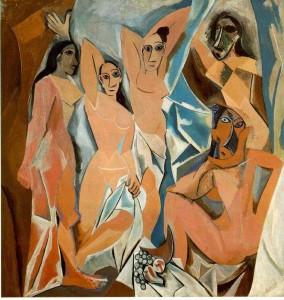On Cubism and Github
Or how creative programmers and artists collaborate.
In 1907 Pablo Picasso painted his seminal work ‘Demoiselles D’avignon’. It was so different and so at odds with the trajectory his work was taking, he set it aside in his studio as he didn’t know what to do with it. On seeing the painting Georges Braque was supposed to have said ‘It is as though you want us to eat rope and drink petrol’. Not a promising start for a collaboration with Picasso that would literally change the face of 20th century art.
However, within a few months both artists were working on variations of this painting and the visual ideas and language that it had introduced. This proved to be enormously fruitful for both artists and soon other painters and sculptors were involved in taking cubism, as it later became known, and using it to explore their own creativity. There is an interesting chart here that shows the development of the visual language and how Picasso, Braque and Gris’s work morphed over time.

The development of collaboration around cubism. Cubistro.com
The power of the ‘ism’ to unlock creativity and put the exploitation of an idea at the heart of creativity is something that has been replicated in the open source software movement generally and more specifically lately through the platform Github. Github allows developers to create code repositories and then if they wish open these up to collaboration, enabling any other developer to ‘branch’ the codebase and work on it in their own way. They may choose to enhance the core software and issue a ‘pull request’ to the original owner for them to merge their amendments into the main code base, and so improve the whole. Alternatively they may ‘fork’ the code and take it entirely in their own direction.
This is effectively what an ism has done for the artworld historically. Like much of mathematical discovery it offers a way for ideas to flow freely through the community, encourages the opportunity to collaborate and produce something better than either party could have created. As communities grow (not too large, but that’s another story) a huge out pouring of creativity and wider value is created.
It is ironic then at a time when the most powerful creative force our planet has ever seen, software engineering, has learned from art history that the ism is the core to creativity and collaboration however remote yields big rewards, artists are being forced to become isms of one.
The post ‘Saatchi’ era of collector art has created an atmosphere where each artist must have an ism of their own. Something that makes their work look like no other. An ad for an idea or technique. This prizing of the individual over the idea, the one over the contribution of the many greatly limits potential creativity. So much so now that the art world is described as one entity in an over-arching era (post-conceptualism or similar). No suprematicism, surrealism, abstract expressionism or positive affirmation of achievement – just a description of what art is not about. The pressure on artists to create collectable and discretely expensive, unique works is killing the possibility of collaboration because their look is their IP (intellectual property) and you don’t need to look far to see how effective that approach is working out in the tech world.
There is a reason that open source software is killing proprietary application businesses, and has killed language-based businesses like Borland. The open source stuff is better and if its not open source its built on the back of open source so its much cheaper and easier for everyone to access.
The explosion of software development has happened on the back of global collaboration through tools like Github, not individual code bases of one. At a time when artists are being forced to be defensive, the software world is being forced to be generous. The results speak for themselves.
Bring back the ism. Release artists to collaborate around thinking and direction, let them argue and disagree, fork and branch their own ideas from the core. In the many there is much more power. Power to make change, power to explore, power to cause effects. The results will be greater than the one.
Where or what is the Github for artists?
Image credits:
Octocat copyright of Github
Demoiselles D’avignon copyright Picasso estate and MOMA
Development of cubism graphic copyright Cubistro.com



